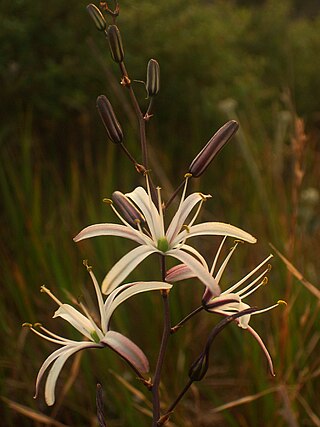
The common names soap plant, soaproot and amole refer to the genus Chlorogalum. They are native to western North America, with some species in Oregon but they are mostly found in California. Common names of the genus and several species derive from their use as soap.

Chlorogalum pomeridianum, the wavy-leafed soap plant, California soaproot, or Amole, is the most common and most widely distributed of the soap plants, soaproots or amoles, which make up the genus Chlorogalum of flowering plants. It is occasionally known as the "wild potato", but given the plant's lack of either resemblance or relationship to the potato, this name is not recommended.

Eriodictyon angustifolium, common name narrowleaf yerba santa, is a perennial shrub.

Allium crispum is a species of wild onion known by the common name crinkled onion. It is endemic to California, where it grows along the Central Coast in the Coast Ranges and in the Santa Monica Mountains, often in clays and serpentine soils. It is a perennial herb that is typically found in the foothill woodlands and valley grasslands of California.

Allium amplectens, the narrowleaf onion, is a species of flowering plant. It is a onion native to the west coast of the United States, in Oregon, Washington State and California, also British Columbia in Canada. It grows in woods and especially in clay and serpentine soils.
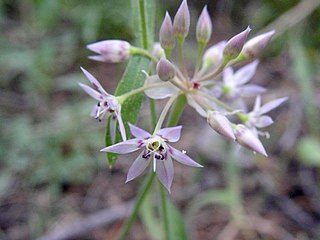
Allium campanulatum is a species of wild onion known by the common name dusky onion or Sierra onion. This is a flowering plant native to the western United States from southeastern Washington and northern Oregon to southern California, and western Nevada. The dusky onion grows in foothills and mountains, especially in dry areas, such as chaparral habitats.

Hooveria purpurea is a species of flowering plant related to the agaves known by the common name purple amole. This species of soap plant is endemic to California, where it grows in the Santa Lucia Range, in the Central Coast region. There are two varieties of this plant, and both are believed to be quite rare. It is a federally listed threatened species.

Galium angustifolium is a species of flowering plant in the coffee family known by the common name narrowleaf bedstraw. It is native to California and Baja California, where it is most commonly found at low elevations in the mountains.

Hastingsia serpentinicola is a species of flowering plant known by the common name Klamath rushlily. It is native to the mountains of northwestern California and southwestern Oregon, where it grows in serpentine soils.
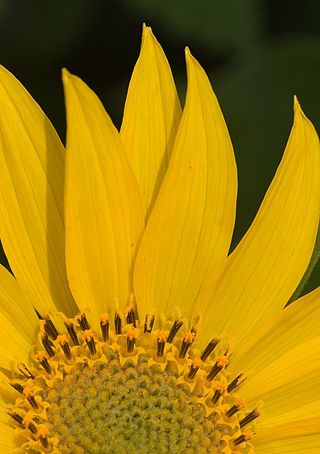
Balsamorhiza deltoidea is a species of flowering plant in the sunflower tribe of the plant family Asteraceae known by the common name deltoid balsamroot. It is native to western North America from British Columbia to California, where it grows in many types of generally mountainous habitat.

Chlorogalum grandiflorum is a species of flowering plant known by the common name Red Hills soap plant. It is endemic to the Sierra Nevada foothills, such as the Red Hills, of California, where it grows in chaparral, woodland, and forest.

Hooveria parviflora is a species of perennial herb in the Agave/Yucca subfamily known by the common name smallflower soap plant. It is a monocot, native to coastal southern California and Baja California, where it is a member of the coastal sage scrub flora. It resembles a smaller version of Chlorogalum pomeridianum, with wavy leaves and white flowers that open during the day.
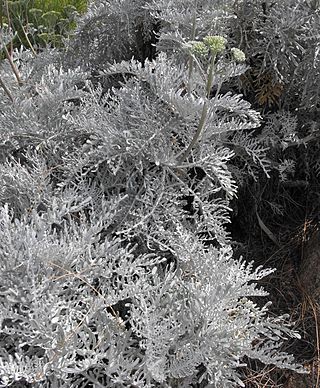
Constancea is a monotypic genus of flowering plants in the family Asteraceae containing the single species Constancea nevinii, which is known by the common name Nevin's woolly sunflower. It is endemic to three of the Channel Islands of California, where it grows in coastal scrub habitat. This is a small shrub or subshrub generally growing up to one or 1.5 meters tall, and taller when an erect form, with a branching, woolly stem. The whitish, woolly oval leaves may be up to 20 centimeters long and are divided into many narrow lobes with edges curled under. The inflorescence is a cluster of 10 to 50 or more small flower heads, each on a short peduncle. The flower head has a center of hairy, glandular, star-shaped yellow disc florets and a fringe of four to nine yellow ray florets, each about 2 millimeters long. The fruit is an achene a few millimeters long with a small pappus at the tip.
Sabulina californica, commonly known as California sandwort, is a species of flowering plant in the family Caryophyllaceae.

Stanleya elata is a species of flowering plant in the family Brassicaceae known by the common name Panamint princesplume. It is native to the desert mountains of eastern California and western Nevada, where it grows in rocky and scrubby habitat types. It may also occur in Arizona. It is a perennial herb producing one or more erect stems reaching about 1.5 meters in maximum height. They are hairless and often waxy in texture. The thick, leathery leaves have lance-shaped or oblong blades with smooth or toothed edges measuring up to 15 centimeters long. They are borne on petioles. The top of the stem is occupied by a long inflorescence which is a dense, snaking raceme of many flowers. Each flower has four narrow, threadlike yellow or whitish petals each about a centimeter long and a millimeter wide. The fruit is a long, thin, wormlike silique which may be 10 centimeters in length. It contains tiny seeds.
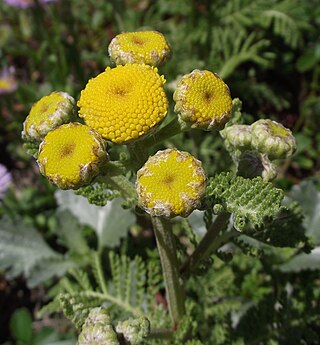
Tanacetum camphoratum is a species of flowering plant in the aster family known by the common names camphor tansy and dune tansy. It is native to the Pacific Coast of North America from British Columbia to California, where it grows in sand dunes and other coastline habitat. This species may be known by the synonym Tanacetum douglasii and is often included in Tanacetum bipinnatum. It is a rhizomatous perennial herb with a thick, low-lying stem up to 25 centimeters long, branching to form a mass of vegetation. It is hairy, glandular, and aromatic, with a camphor scent. The leaves are up to 25 centimeters long and thick but featherlike, divided into many narrow leaflets on each side of the main rachis. Each leaflet in turn has many segments along each side, and the segments are usually divided into several small, knobby segments with folded or curled edges. The inflorescence bears up to 15 flower heads, each about a centimeter wide or slightly wider. Each head contains many yellowish disc florets and many pistillate florets around the edges. The latter may have minute ray florets. The fruit is an achene a few millimeters long which is tipped with a small pappus of toothed scales.

Trifolium angustifolium is a species of clover known by the common names narrowleaf crimson clover, narrow clover and narrow-leaved clover.

Wyethia angustifolia is a species of flowering plant in the family Asteraceae known by the common names California compassplant and narrowleaf mule's ears. It is native to the west coast of the United States from Washington to California, where it grows in grassland, meadows, and other open habitat. It is a perennial herb growing from a tough taproot and caudex unit and producing a stem 30 to 90 centimeters tall. The leaves have lance-shaped blades up to 50 centimeters tall. The inflorescence produces one or more large sunflower-like flower heads at the top of the hairy stem. The head has narrow, hairy phyllaries at the base. It contains up to 21 yellow ray florets each up to 4.5 centimeters long and many yellow disc florets. The fruit is an achene which may be nearly 2 centimeters long including its pappus.

Tetraneuris acaulis is a North American species of flowering plants in the sunflower family. Common names include angelita daisy, stemless four-nerve daisy, stemless hymenoxys, butte marigold, and stemless rubberweed.

Cardamine douglassii, the limestone bittercress or purple cress, is a perennial forb native to the eastern and central United States as well as the province of Ontario in Canada, that produces white to pink or purple flowers in early spring.



















